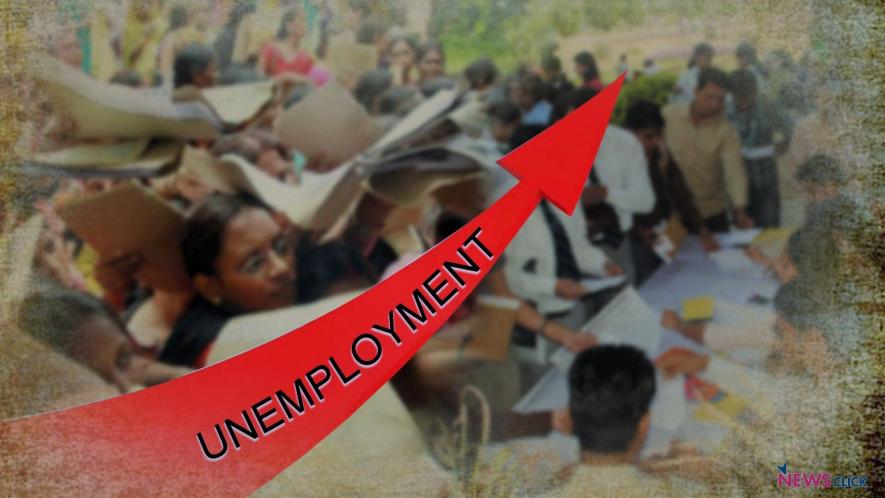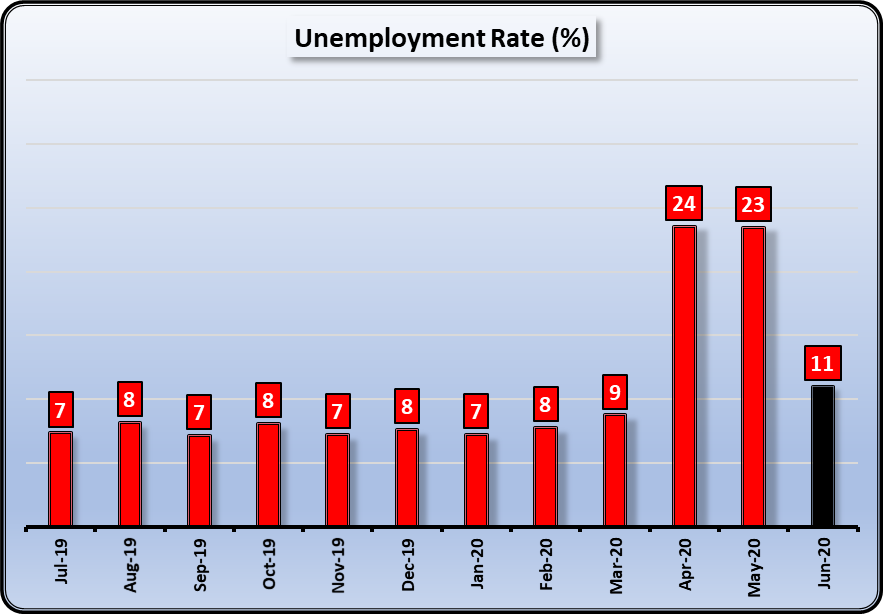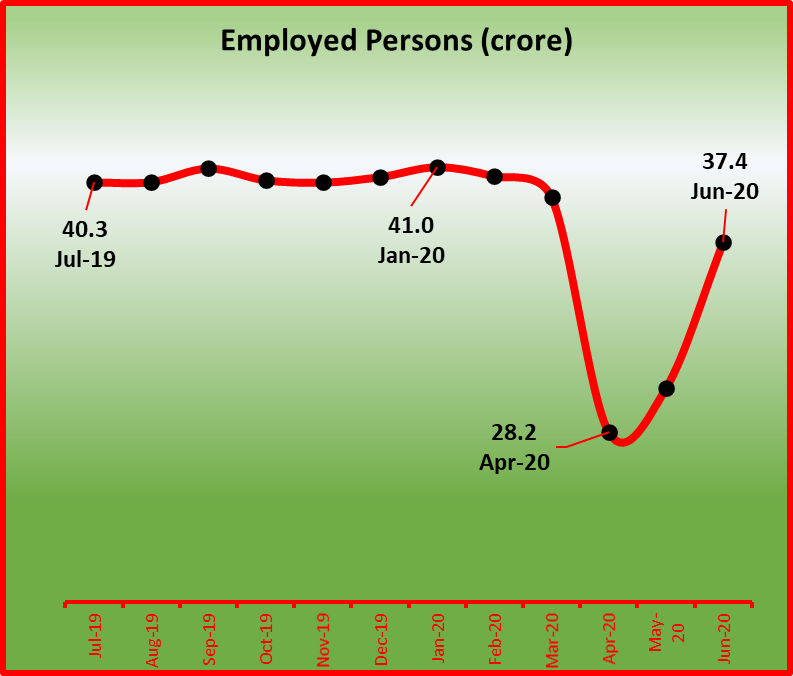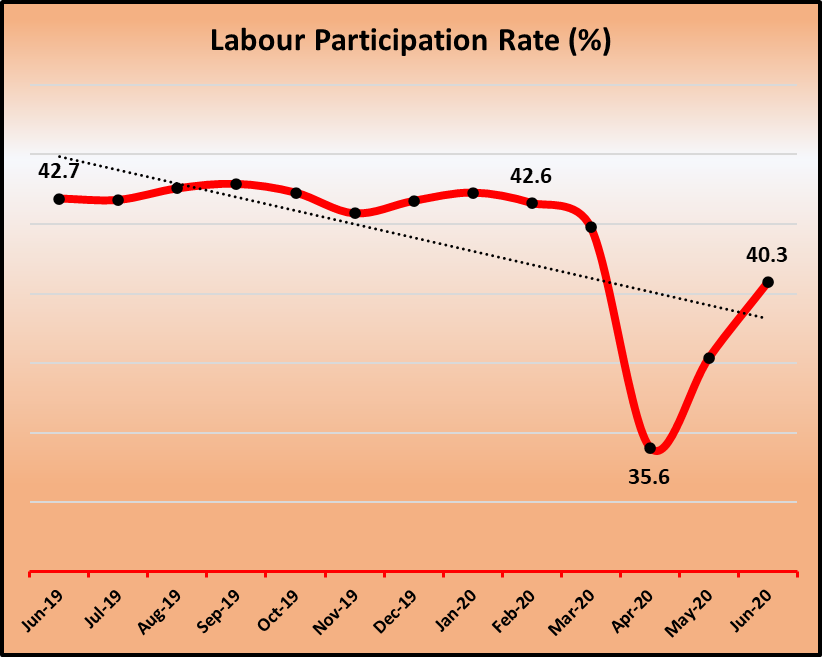Job Situation Continues to Be Grim Despite ‘Unlock’ and Govt’s Concessions to Rich

The average jobless rate in India was pegged at 11% in June 2020, while the labour participation rate was estimated at 40.3%, according to latest data from the sample surveys periodically carried out by Centre for Monitoring Indian Economy (CMIE). These are the only current estimates of employment available in India.
While the jobless rate of 11% is a sharp fall from the very high levels reached during April and May this year, it is still a very worrying trend. The high level in April-May was a direct result of the ill-conceived and badly planned lockdown that went on for over two months and brought the Indian economy to a juddering halt. Since the lockdown didn’t control the pandemic – cases are still rising steeply in India – the combination of the disease and its remedy had a lethal effect on employment across the board.
It was expected that once Unlock 1.0 began on June 1 this year, the economy will bounce back as will employment. This did happen to an extent (see chart below), but the level at which the jobless rate has settled now is a cause of serious worry. Unemployment has been ranging at about 7-8% last year. Now, it has settled at 11%. Latest weekly data of CMIE, in fact, shows that this could be the new normal in pandemic-stricken India.

Most Jobs in Farming
Meanwhile, the number of employed persons too has shrunk by a whopping 3 crore (30 million) compared to the pre-pandemic levels. [See chart below] In February this year, the number of employed was estimated by CMIE to be about 40.6 crore (406 million). This plummeted in April and May to unprecedented levels, but recovered somewhat in June to 37.4 crore (374 million). That still leaves 3 crore Indians who were employed just a few months ago on the streets.

It is estimated that most of this return to work from locked down April and May took place in farming. Average employment in farming in 2019-20 was 11.1 crore (111 million), June 2020 has witnessed a huge increase to a record 13 crore (130 million). So, nearly 2 crore (20 million) people have been absorbed in farming this June.
While early monsoon rains this year and consequent surge in early kharif sowing has led to this dramatic rise in farming jobs, this swelling of farming jobs also denotes an over-saturation of the sector. People without jobs are flocking to do whatever farming work they can get, or simply helping out in families’ own farming work. It does not mean any additional income – the same pie is going to be cut in smaller pieces. It also means that already depressed wages of agricultural labourers will remain depressed, or may fall even further. Too many workers for the same work can have only that effect. So, this rise in farming employment is actually disguised unemployment. It is neither sustainable nor of any great use to people.
Other categories where CMIE estimates that jobs have increased after the lockdown eased include small traders and daily wage labourers, and ‘business persons’. Seen together, all these categories of workers/earners are mainly self-employed people or those who are hired for doing physical work on a daily wage basis. It is obvious that these people will return to work earlier because they would usually be doing individual work, near their homes, and also because they would need to start working at the earliest.
Also read: COVID-19: Pessimism Pervades Jewellery Trade, Exodus of Karigars Continues
But among salaried employees, the CMIE estimates show a dire situation. Some 8.6 crore (86 million) persons, making up over a fifth of India’s workforce of about 40.4 crore (404 million), were working as salaried employees. They range from factory workers to employees in the services sector, including offices. The lockdown saw over 1.76 crore (17.6 million) of these employees lose their jobs in April – a massive blow to a large chunk of the population. Yet, the so-called opening up of the economy and Unlock 1.0 has done little to bring back this hapless section to work. That’s because no amount of monetary incentives like easy bank credit have lured MSMEs or large factories and establishments to resume productive activities. According to CMIE estimates, only about 39 lakh such employees have rejoined work, thus leaving another 1.4 crore (137 million) people out of work.
People Opting Not to Work At All
Fear of the raging pandemic and the lack of confidence in governments’ abilities to control it, coupled with the lack of decent jobs in nearby places has caused a large number of people to simply become hopeless and effectively opt out of the labour force itself. A large share of them are women who appear to have suffered more, according to some studies. This can be seen in the drop in the labour participation rate (LPR), which is the share of the working-age population that is either working or willing to work. In other words, it is the sum of employed and unemployed taken as a proportion of the whole working-age population.
As the chart below shows, LPR had remained steady at around 43% through last year and the early months of this year before precipitously dropping to just 35.6% in April this year, as a direct consequence of the lockdown. Since then it has recovered to around 40% in June this year – still below last year’s levels.

What this means is that a large number of persons – approximately 2.5% of the working-age population or about 2 crore (20 million) persons – have stopped even looking for work after losing jobs in the lockdown. This is also a huge chunk of unemployed people.
Government policy, blinkered by its dogmatic commitment to incentivising the rich in the fond hope that it will help boost investment and employment, has spectacularly failed. The lockdown shock has brought out this failure in stark relief. And, there doesn’t seem to be any major rethinking on the government’s part to correct their course. India thus continues to go through a distressing time as the people fight, both, the pandemic and their sinking earnings and livelihoods.
Also watch: Corporate Interests are Determining US Response to COVID-19
Get the latest reports & analysis with people's perspective on Protests, movements & deep analytical videos, discussions of the current affairs in your Telegram app. Subscribe to NewsClick's Telegram channel & get Real-Time updates on stories, as they get published on our website.
























